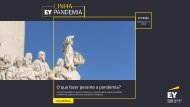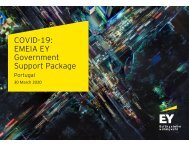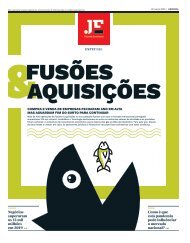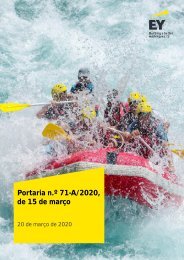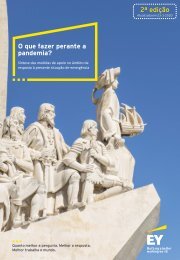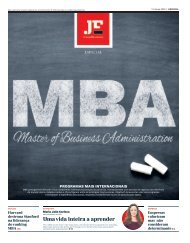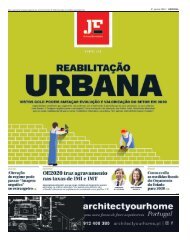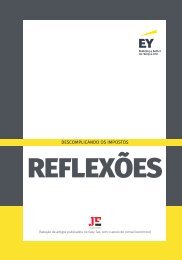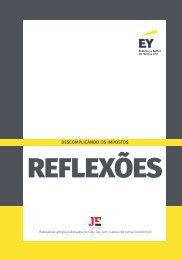MAIS TIC
Create successful ePaper yourself
Turn your PDF publications into a flip-book with our unique Google optimized e-Paper software.
Educação Internacional, 9 novembro 2018 | 5<br />
OPINIÃO OPINION<br />
Diálogo de Culturas<br />
ELENA BEKHTIEVA<br />
Editora principal da revista “Arte Russa”<br />
Main editor of the<br />
“Russian Art” magazine<br />
Cultures’ Dialogue<br />
Há dias realizou-se a Semana da<br />
Cultura Russa, na qual participei.<br />
Nãoéaprimeiravezqueofaço,<br />
porisso,sublinhooaltonívelda<br />
organização da iniciativa realizada<br />
em Cascais. Nunca anteriormente<br />
se verificou tanta diversidade<br />
da cultura russa num evento<br />
comumformatoqueincluiuarte,<br />
ciência, música, literatura e cinema<br />
ao mesmo tempo.<br />
Começo com as belas artes,<br />
onde trabalho há 25 anos. A divulgação<br />
da religião ortodoxa e da<br />
pinturadeícones,aartelaicaea<br />
arquitetura, a literatura russa,<br />
todo esse mundo foi abrangido<br />
pela revista “Arte Russa”. A apresentação<br />
da edição especial da revista<br />
em português, inteiramente<br />
dedicada ao diálogo entre as culturasdaRússiaedePortugal,realizou-se<br />
no dia 16 de outubro, na<br />
presença do representante do PatriarcadeMoscovoedetodaa<br />
Rússia junto do Patriarca de Antioquia<br />
e de todo o Oriente (Damasco),<br />
doutor em Teologia, padre<br />
Arseny, na sua qualidade de<br />
autor. O seu discurso sobre a vida<br />
e o serviço religioso na Península<br />
Ibérica e especificamente em Portugal,<br />
anteriormente publicado<br />
no “Caderno Ibérico”, gerou<br />
grande interesse e ajudou os leitores<br />
a entenderem melhor o caráter<br />
da Nação portuguesa.<br />
Os membros da delegação<br />
russa, entre os quais a restauradora<br />
emérita de Moscovo, chefe<br />
de seção do Museu Kolomenskoe,<br />
Ekaterina Satel, e a<br />
professora da Academia de Belas<br />
Artes de Ilha Glazunov, investigadora<br />
das tradições clássicas<br />
e contemporâneas de arte<br />
ocidental europeia, Nina Getashvili,<br />
lideraram as conferências<br />
dedicadas aos problemas de<br />
preservação do tesouro de arte<br />
edosmétodosderestaurodos<br />
ícones russos. Salientaram a<br />
importância das relações culturaisentreosdoispaíses,nomeadamente<br />
o trabalho artístico<br />
dos pintores portugueses expostos<br />
em Moscovo e São Petersburgo<br />
e enfatizaram o valor<br />
da arquitetura Manuelina em<br />
Lisboa, a peculiaridade de Setúbaleanaturezadaregiãode<br />
Sintra como formas de inspiração<br />
artística dos pintores russos.<br />
A mostra de ilustrações,<br />
acompanhada pela tradução<br />
emotiva de José Milhazes, tornou<br />
as conferências atrás referidas<br />
ainda mais impressionantes.<br />
As obras decorativas aplicadasdo<br />
acervo pessoal de Irina<br />
Marcelo Curto foram apresentadas<br />
ao público na Casa de Santa<br />
Maria. Os objetos expostos<br />
nas vitrinas iluminadas - lenços<br />
de Pavloposad, cerâmica de<br />
Gzel, louça de madeira de pintura<br />
Khokloma, miniaturas laqueadas<br />
de Palekh, samovares<br />
antigos de Tula - fundiram-se<br />
em síntese harmoniosa com os<br />
azulejos que decoram as paredes<br />
da sala.<br />
Amostradecinemarussono<br />
Cinema da Villa, com a presença<br />
do realizador Vadim Abdrashitov<br />
e os seus dois filmes internacionalmente<br />
famosos, juntamente<br />
com um outro do realizador<br />
russo Nikita Mikhalkov, foi<br />
outro ponto alto da Semana. Na<br />
iniciativa, a música russa foi representada<br />
pelo Trio Balalaika<br />
da Orquestra Académica Nacional<br />
dos instrumentos tradicionais<br />
de N.P. Osipov com a interpretação,<br />
entre outras, de canções<br />
famosas como Kalinka -<br />
“Kamarinskaya”.<br />
É indiscutível que iniciativas<br />
desta natureza e grandiosidade<br />
servem para aproximar e promoverummelhorconhecimento<br />
dos povos russo e português,<br />
facilitando o diálogo entre as<br />
duas culturas. ●<br />
the most important points to make<br />
known to the children of the<br />
schools that visit the exhibition<br />
“Russian Art and Culture”.<br />
The relationship between Portugal<br />
and Russia in multiple fields is<br />
very old, including wine - Madeira<br />
andPorto-andthestayofRussian<br />
artists in Madeira Island, of which<br />
the most known one was Karl Briullov<br />
in the 19th century, who painted<br />
there some of his most famous<br />
paintings, which can now be seen in<br />
the Tretyakov Gallery in Moscow<br />
and the Hermitage Museum in St.<br />
Petersburg. This is reversal. The love<br />
story of Inês de Castro and D.<br />
PedrodePortugalisareferencefor<br />
any Russian worship. This story,<br />
which touches the Russians’ emotions,<br />
is told in the magazine “Russian<br />
Art”, a publication in Russian,<br />
now translated into Portuguese.<br />
The Portuguese edition, presented<br />
at the opening ceremony of V Cultural<br />
Russian Week, is brought by<br />
the Pavel Tretyakov Foundation,<br />
supported by the Portuguese foundations<br />
Sharing and D. Luís I, and<br />
sponsored by the Estoril Sol group.<br />
Salvato Telles de Menezes, president<br />
of the foundation D. Luís I,<br />
highlighted the importance of the<br />
initiative in Cascais. Sílvio Sousa<br />
Santos, president of the Sharing<br />
Foundation, highlighted multiculturalism<br />
and its contribution to the<br />
rapprochement between different<br />
peoples.<br />
At the Russian Cultural Week,<br />
which is already in its fifth edition,<br />
the theme of Education is a link<br />
that allows to extend the scope of<br />
the initiative, due to the involvement<br />
of schools. “It is gratifying to<br />
see that children and young people<br />
are pleasantly surprised and motivated<br />
to deepen their knowledge in<br />
Russian language”, concludes Júlia<br />
Ladeira Santos. ●<br />
A few days ago the Russian Cultural Week, in which<br />
I participated, has come to an end. This is not the<br />
first time I participate in this event; thus, I underline<br />
the high level of the organization of this initiative<br />
held in Cascais. Never before has there been<br />
such diversity of Russian culture in an event that<br />
included art, science, music, literature and film at<br />
thesametime.<br />
I begin with the fine arts, where I have been<br />
working for 25 years. The magazine “Russian Art”<br />
covered the dissemination of the Orthodox religion<br />
and icon painting, secular art and architecture and<br />
Russian literature. The presentation of the magazine’s<br />
special edition in Portuguese, entirely devoted<br />
to the dialogue between the Russian and<br />
Portuguese cultures, was held on October 16 in the<br />
presence of the representative of the Patriarch of<br />
Moscow and of Russia with the Patriarch of<br />
Antioch and of all the East (Damascus), Doctor of<br />
theology, Father Arseny, in his capacity as author.<br />
His speech on life and religious service in the<br />
Iberian Peninsula, specifically in Portugal, previously<br />
published in the “Iberian Notebook”, generated<br />
great interest and helped readers to better understand<br />
the character of the Portuguese Nation.<br />
Members of the Russian delegation, including the<br />
emeritus restaurateur of Moscow, section chief of<br />
the Kolomenskoe Museum, Ekaterina Satel, and the<br />
professor at the Glazunov Island Academy of Fine<br />
Arts, a researcher on the classical and contemporary<br />
traditions of Western European art, Nina<br />
Getashvili, led the conferences dedicated to the<br />
problems of preservation of the treasure of art and<br />
methods of restoration of Russian icons. They<br />
emphasized the importance of cultural relations<br />
between the two countries, namely the artistic<br />
work of the Portuguese painters exhibited in<br />
Moscow and St Petersburg, and emphasized the<br />
value of Manueline architecture in Lisbon, peculiarity<br />
of Setúbal and the nature belonging to Sintra<br />
region as forms of artistic inspiration for Russian<br />
painters. The exhibition of illustrations, accompanied<br />
by the emotional translation of José Milhazes,<br />
made the mentioned conferences even more<br />
impressive.<br />
The Russian decorative and applied works of the<br />
personal collection of Irina Marcelo Curto were presented<br />
to the public in Casa de Santa Maria. The<br />
objects exhibited in the illuminated showcases:<br />
Pavloposad handkerchiefs, Gzel pottery, Khokloma<br />
woodwork, Palekh lacquered miniatures, ancient<br />
samovars of Tula, merged harmoniously with the<br />
tiles that decorate the walls of the Museum’s room.<br />
The Russian cinema show at the Villa’s Cinema,<br />
with the presence of director Vadim Abdrashitov<br />
and his two internationally famous films, along<br />
with one by Russian director Nikita Mikhalkov, was<br />
another highlight of Russian Week. In the initiative,<br />
Russian music was represented by Trio Balalaika of<br />
the National Academic Orchestra of the traditional<br />
instruments of N.P. Osipov with the interpretation<br />
of famous songs like Kalinka, Kamarinskaya, among<br />
others.<br />
It is indisputable that initiatives of this nature and<br />
grandeur serve to bring together and promote a<br />
better knowledge of the Russian and Portuguese<br />
peoples, facilitating the dialogue between the two<br />
cultures.





